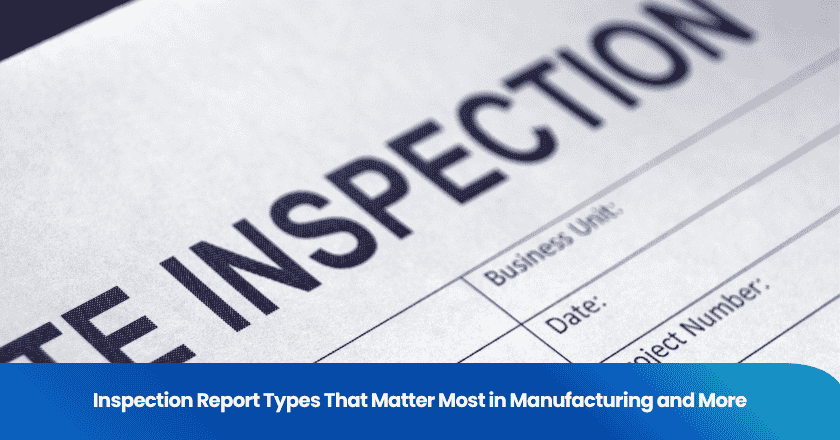
You rely on several inspection report types to drive manufacturing success, including pre-production, in-process, and final inspection reports. These reports play a vital role in keeping operations safe and products high in quality. When you use inspection reports, you help your organization meet compliance standards, reduce risks, and boost performance.
You can see faster analysis, better prediction accuracy, and cost savings from prevented quality issues. Choose inspection report types that suit your industry’s unique needs.
Why Inspection Reports Matter
Purpose of Inspection Reports
You use inspection reports to document and evaluate processes, products, and environments across industries. These reports serve as a foundation for decision-making and continuous improvement. When you conduct an inspection, you verify production accuracy, prevent costly mistakes, and establish a baseline for quality. Inspection reports also improve communication between suppliers and buyers, supporting regulatory compliance and industry standards.
You rely on inspection reports to maintain high-quality standards, which directly impacts your brand reputation and customer satisfaction. These reports ensure you meet regulatory compliance, reducing the risk of legal issues and penalties. Regular inspections help you identify potential hazards and ensure product safety before products reach consumers.

Impact on Safety and Quality
Inspection reports play a critical role in workplace safety and product quality. Accurate and comprehensive data gathering is essential for health and safety reports. You use inspection records to identify hazards and ensure compliance with safety standards. Thorough inspections contribute to improved safety and quality outcomes.
Site inspections ensure adherence to local and international safety standards. They help prevent safety hazards and accidents, protecting workers. Inspections maintain the quality and integrity of projects, aligning with client expectations.
You see the importance of inspection reports in supporting compliance, reducing risk, and driving operational efficiency. These reports help you meet industry standards and deliver consistent, high-quality results.
Main Types of Inspection Reports
Inspection reports form the backbone of quality assurance in manufacturing. You rely on several types of inspections to maintain control over your processes and deliver consistent results. Each inspection report serves a unique purpose and occurs at a specific stage in the production cycle. Understanding these differences helps you choose the right approach for your operations.
| Type of Inspection | Definition and Purpose |
|---|---|
| Incoming Inspection | Verifies that raw materials and components meet specifications before production, preventing disruptions. |
| In-Process Inspection | Conducted at key stages in manufacturing to ensure critical parameters remain within control limits. |
| Final Inspection | The last quality check before products are shipped, ensuring compliance with release criteria. |
| Specialized Inspections | Uses advanced testing methods for specific applications, such as Non-Destructive Testing. |
Pre-Production Inspection Report
You start with a pre-production inspection report to set the foundation for quality. This inspection takes place before production begins. You check raw materials and components to ensure they meet your standards. You also verify that machinery and setups are ready for efficient operation.
Tip: Develop clear quality standards based on product specifications and regulatory requirements. Train your inspectors to recognize issues early.
A typical pre-production inspection report includes:
1. Material Verification: You confirm that all incoming materials match the required specifications.
2. Component Inspection: You check that each component meets design and quality criteria.
3. Setup Check: You ensure machines are calibrated and ready for production.
You prevent quality issues by catching problems before they enter the production line. This step reduces the risk of costly rework and delays. Industry organizations recommend conducting this inspection to avoid disruptions and maintain compliance with standards.
In-Process Inspection Report
In-process inspection reports keep your production on track. You conduct these inspections at critical points during manufacturing. You monitor parameters like dimensions, weight, and appearance to ensure everything stays within control limits.
You use in-process inspection reports to identify and address issues as they arise. This proactive approach leads to better resource management and higher customer satisfaction. For example, a shoe manufacturer in San Diego reduced their defect rate by 30% after implementing regular in-process inspections. This saved significant costs and improved efficiency.
Final Inspection Report
The final inspection report acts as your last line of defense before products leave your facility. You use this inspection to confirm that finished goods meet all specifications and quality requirements. You check for defects, verify packaging, and ensure compliance with buyer expectations.
Note: Companies with robust final quality inspection programs report a 20% increase in customer satisfaction compared to those without.
You rely on the final inspection report to safeguard your brand reputation. This step ensures that only products meeting your standards reach customers. The final quality inspection also helps you comply with industry regulations and avoid costly returns or recalls.
You see that each inspection report type plays a vital role in your quality management system. By using pre-production, in-process, and final inspection reports, you create a robust framework for continuous improvement and operational excellence.
Quality Inspections in Manufacturing
Pre-Production Quality Inspections
You begin your quality control process with pre-production quality inspections. These inspections focus on verifying the quality and quantity of raw materials before production starts. You check that all materials meet your specifications and standards. This step prevents defects and ensures a smooth workflow. When you conduct comprehensive inspections at this stage, you set a strong foundation for quality assurance.
During Production Quality Inspections
During production quality inspections play a critical role in maintaining quality assurance. You monitor the manufacturing process to catch defects early. This approach helps you save materials and reduce labor costs. You identify issues such as incorrect raw materials, assembly errors, and inconsistent workmanship before they escalate. By intervening early, you avoid excessive waste and minimize the risk of costly mistakes.
- Catching defects during production helps you save materials and reduce labor costs.
- You can identify issues like incorrect raw materials and assembly errors before they become larger problems.
- Early detection of defects helps you avoid waste and reduce costs from rework or scrapping.
- Intervening early in the process mitigates the risk of costly mistakes.
Pre-Shipment Quality Inspections
Pre-shipment quality inspections serve as your final checkpoint before products reach customers. You ensure that finished goods meet all quality standards and buyer requirements. This step lowers the chance of returns and prevents poor-quality products from entering the market. You save time, money, and resources by avoiding recalls. If you discover major defects, you can halt shipment and address issues before products leave your facility.
1. You ensure products meet quality standards before shipment.
2. You reduce the risk of defective goods reaching customers.
3. You protect your brand reputation and provide peace of mind.
Container Loading Inspections
Container loading inspections focus on the final stage of the shipping process. You verify that products are packed and loaded correctly to prevent damage during transit. This inspection report confirms that all goods meet specifications and that packaging is secure. By conducting quality inspections at this stage, you maintain quality assurance throughout the supply chain and ensure products arrive safely at their destination.
Maintenance Inspections and Reports
Types of Maintenance Inspections
You rely on different types of maintenance inspections to keep your facility running smoothly. Each inspection focuses on specific assets and systems. A well-structured maintenance inspection checklist helps you cover all critical areas and maintain compliance with industry standards.
You use these inspections to ensure safety, reliability, and quality across your operations.
Preventive Maintenance Inspections
Preventive maintenance inspections form the backbone of your equipment care strategy. You perform regular checks and adjustments to prevent equipment failure. This approach increases reliability and reduces downtime.
- You identify minor issues before they escalate.
- Regular upkeep reduces wear and tear.
- Planned maintenance avoids emergency repairs and rush parts orders.
A routine maintenance check, guided by a maintenance inspection checklist, helps you catch problems early and save on costs.
Tip: Schedule preventive maintenance inspections based on manufacturer recommendations and operational demands.
Corrective Maintenance Inspections
You use corrective maintenance inspections to address equipment failures as soon as they occur. This process starts with problem identification, often triggered by alarms or staff observations.
1. You identify and report the issue.
2. You assess the problem using a maintenance inspection checklist.
3. You repair or restore the equipment to working order.
Corrective maintenance is reactive, but it remains essential for restoring operations quickly and minimizing downtime.
Condition Monitoring Reports
Condition monitoring reports help you predict equipment failures before they disrupt production. You set monitoring parameters and install sensors on critical parts. These sensors collect real-time data, which you analyze for irregularities.
- You detect developing faults before they become costly failures.
- You schedule maintenance proactively.
- You reduce unplanned downtime and improve equipment effectiveness.
A detailed maintenance inspection checklist ensures you capture all necessary data for your inspection report and maintain high standards of quality.
Safety Inspection Report Types
Workplace Safety Inspections
You conduct workplace safety inspections to identify hazards and maintain a safe environment. These inspections form the foundation of any workplace safety audit. In industrial settings, you often use several types of safety inspection reports:
1. Workplace Inspections
2. Hazard Reports
3. Incident Reports
Routine inspections help you spot risks before they cause harm. You also ensure compliance with safety regulations and promote a culture of safety. The table below shows how key elements of workplace safety inspections contribute to accident prevention:
| Key Element | Contribution to Accident Prevention |
|---|---|
| Routine Inspections | Identify potential hazards before they lead to accidents. |
| Compliance with Safety Regulations | Helps avoid costly violations and ensures adherence to safety standards. |
| Improved Productivity & Efficiency | Reduces disruptions and downtime caused by workplace injuries. |
| Lower Insurance & Liability Costs | Decreases expenses related to workers' compensation and insurance. |
| Promotes a Culture of Safety | Encourages proactive risk identification among employees. |
Tip: Regular inspections and clear documentation help you maintain high safety standards and reduce liability.
Health and Safety Inspection Reports
You rely on health and safety inspection reports to document findings and drive improvements. These reports follow industry standards and often include:
| Component | Description |
|---|---|
| Documentation of findings | Comprehensive recording of all findings during the inspection. |
| Observations | Detailed notes on the conditions observed during the inspection. |
| Recommendations | Suggestions for improvements or actions to be taken based on the findings. |
| Prioritization | Ranking of required actions based on severity and urgency, including timelines and responsibilities. |
Across industries, you see these reports influenced by international standards such as ISO 45001. You emphasize employee participation and ensure compliance with legal requirements.
Inspection Report Fields and Best Practices
Essential Inspection Report Fields
You need to include specific inspection report fields to ensure your inspection report is complete and compliant with industry standards. These fields help you document every aspect of the inspection and provide a clear record for future reference.
1. Report Date: Marks when the inspection took place, establishing a timeline.
2. Inspector Information: Identifies who performed the inspection, adding accountability.
3. Property or Asset Location: Specifies the exact site or equipment inspected.
4. Purpose of Inspection: Explains why you conducted the inspection.
5. Inspection Checklist: Lists all items and areas reviewed, ensuring consistency.
6. Findings and Observations: Details the conditions found during the inspection.
7. Photos and Attachments: Adds visual proof to support your findings.
8. Severity Rating: Ranks the urgency of each issue, helping you prioritize.
9. Recommended Actions: Suggests steps to resolve problems.
10. Signatures and Approvals: Confirms that all parties acknowledge the report.
Including these inspection report fields ensures you capture all necessary information and maintain high quality in your documentation.
Tips for Effective Reporting
You can improve your inspection reports by following best practices that promote clarity and consistency:
1. Set clear inspection criteria before you begin. This keeps everyone aligned and ensures fair evaluations.
2. Use standard operating procedures to guide your inspections. SOPs help you avoid errors and confusion.
3. Assign qualified inspectors to each inspection. Experienced staff increase accuracy and reliability.
4. Document findings accurately and thoroughly. Good records help you spot trends and maintain compliance with standards.
Tip: Always use a severity rating for each issue. This helps you address the most urgent problems first and supports better decision-making.
Digital Tools for Inspection Reports
Digital tools streamline your inspection process and improve the quality of your reports. Many platforms offer features such as automated checklists, real-time dashboards, and mobile inspection capabilities. These tools help you standardize inspection report fields, automate data collection, and share findings instantly.
Digital solutions also provide benefits like improved accuracy, cost savings, and easier collaboration. You can conduct inspections on the go, manage data centrally, and ensure your inspection report fields remain consistent across all reports.
Choosing the right inspection report for your industry ensures you meet quality and safety standards. Effective inspection reporting supports operational goals and reduces risks. Companies that use standardized inspections see higher customer satisfaction and fewer returns, as shown below:
| Evidence Type | Description |
|---|---|
| Customer Satisfaction Increase | Companies saw a 15% rise in satisfaction ratings. |
| Return Rate Reduction | Quality assurance prevented up to 60% of returns. |
| Compliance Improvement | OSHA violations dropped by nearly 10% in 2024. |
To improve your process, review findings, implement corrective actions, communicate results, monitor progress, and plan future inspections. Regularly update your inspection process to align with current standards.
FAQ
What is the main purpose of an inspection report?
You use inspection reports to document findings, track compliance, and support decision-making. These reports help you identify issues early, maintain quality, and ensure safety in your operations.
How often should you conduct inspections in manufacturing?
You should schedule inspections based on industry standards, equipment type, and operational needs. Regular inspections—such as daily, weekly, or monthly—help you catch problems before they escalate.
What should you include in a quality inspection report?
You should include the inspection date, inspector’s name, location, checklist, findings, photos, severity ratings, and recommended actions. This information ensures your report is complete and actionable.
Why are digital inspection tools important?
Digital tools help you standardize reports, automate data collection, and share results instantly. You improve accuracy, save time, and make collaboration easier across your team.
Can inspection reports help you meet regulatory requirements?
Yes. Inspection reports provide documented proof of compliance. You use them to show auditors and regulators that you follow safety and quality standards.
Grow your business with TradeAider Service
Click the button below to directly enter the TradeAider Service System. The simple steps from booking and payment to receiving reports are easy to operate.


